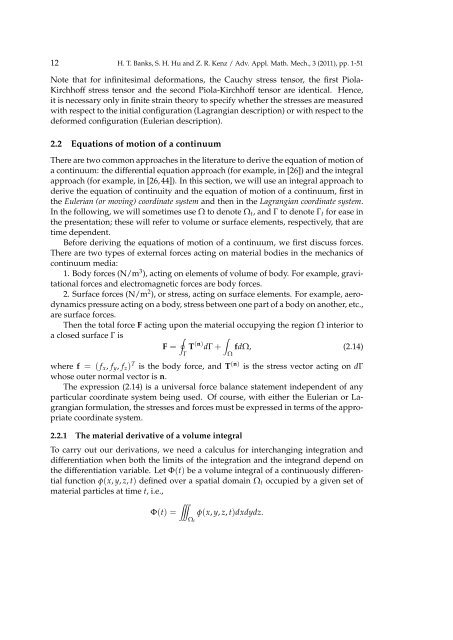A Brief Review of Elasticity and Viscoelasticity for Solids 1 Introduction
A Brief Review of Elasticity and Viscoelasticity for Solids 1 Introduction
A Brief Review of Elasticity and Viscoelasticity for Solids 1 Introduction
Create successful ePaper yourself
Turn your PDF publications into a flip-book with our unique Google optimized e-Paper software.
12 H. T. Banks, S. H. Hu <strong>and</strong> Z. R. Kenz / Adv. Appl. Math. Mech., 3 (2011), pp. 1-51<br />
Note that <strong>for</strong> infinitesimal de<strong>for</strong>mations, the Cauchy stress tensor, the first Piola-<br />
Kirchh<strong>of</strong>f stress tensor <strong>and</strong> the second Piola-Kirchh<strong>of</strong>f tensor are identical. Hence,<br />
it is necessary only in finite strain theory to specify whether the stresses are measured<br />
with respect to the initial configuration (Lagrangian description) or with respect to the<br />
de<strong>for</strong>med configuration (Eulerian description).<br />
2.2 Equations <strong>of</strong> motion <strong>of</strong> a continuum<br />
There are two common approaches in the literature to derive the equation <strong>of</strong> motion <strong>of</strong><br />
a continuum: the differential equation approach (<strong>for</strong> example, in [26]) <strong>and</strong> the integral<br />
approach (<strong>for</strong> example, in [26,44]). In this section, we will use an integral approach to<br />
derive the equation <strong>of</strong> continuity <strong>and</strong> the equation <strong>of</strong> motion <strong>of</strong> a continuum, first in<br />
the Eulerian (or moving) coordinate system <strong>and</strong> then in the Lagrangian coordinate system.<br />
In the following, we will sometimes use Ω to denote Ω t , <strong>and</strong> Γ to denote Γ t <strong>for</strong> ease in<br />
the presentation; these will refer to volume or surface elements, respectively, that are<br />
time dependent.<br />
Be<strong>for</strong>e deriving the equations <strong>of</strong> motion <strong>of</strong> a continuum, we first discuss <strong>for</strong>ces.<br />
There are two types <strong>of</strong> external <strong>for</strong>ces acting on material bodies in the mechanics <strong>of</strong><br />
continuum media:<br />
1. Body <strong>for</strong>ces (N/m 3 ), acting on elements <strong>of</strong> volume <strong>of</strong> body. For example, gravitational<br />
<strong>for</strong>ces <strong>and</strong> electromagnetic <strong>for</strong>ces are body <strong>for</strong>ces.<br />
2. Surface <strong>for</strong>ces (N/m 2 ), or stress, acting on surface elements. For example, aerodynamics<br />
pressure acting on a body, stress between one part <strong>of</strong> a body on another, etc.,<br />
are surface <strong>for</strong>ces.<br />
Then the total <strong>for</strong>ce F acting upon the material occupying the region Ω interior to<br />
a closed surface Γ is<br />
∮<br />
∫<br />
F = T (n) dΓ + fdΩ, (2.14)<br />
Γ<br />
Ω<br />
where f = ( f x , f y , f z ) T is the body <strong>for</strong>ce, <strong>and</strong> T (n) is the stress vector acting on dΓ<br />
whose outer normal vector is n.<br />
The expression (2.14) is a universal <strong>for</strong>ce balance statement independent <strong>of</strong> any<br />
particular coordinate system being used. Of course, with either the Eulerian or Lagrangian<br />
<strong>for</strong>mulation, the stresses <strong>and</strong> <strong>for</strong>ces must be expressed in terms <strong>of</strong> the appropriate<br />
coordinate system.<br />
2.2.1 The material derivative <strong>of</strong> a volume integral<br />
To carry out our derivations, we need a calculus <strong>for</strong> interchanging integration <strong>and</strong><br />
differentiation when both the limits <strong>of</strong> the integration <strong>and</strong> the integr<strong>and</strong> depend on<br />
the differentiation variable. Let Φ(t) be a volume integral <strong>of</strong> a continuously differential<br />
function ϕ(x, y, z, t) defined over a spatial domain Ω t occupied by a given set <strong>of</strong><br />
material particles at time t, i.e.,<br />
∫∫∫<br />
Φ(t) = ϕ(x, y, z, t)dxdydz.<br />
Ω t

















